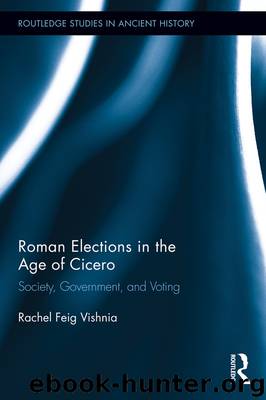Roman Elections in the Age of Cicero by Feig Vishnia Rachel;

Author:Feig Vishnia, Rachel;
Language: eng
Format: epub
Publisher: Routledge
Voters in the centuriate assembly voted in descending order of rank and results were announced immediately after each group had voted. Initially, the first centuria to vote (centuria praerogativa) was drawn by lot from among the eighteen centuriae of equites; it was followed by the votes of the remaining seventeen equestrian centuriae and the eighty centuriae of the first class. If these ninety-eight centuriae all voted in the same way—as indeed was often the case—there was no point in continuing the vote with the remaining ninety-five centuriae, as only a simple majority was required. If votes within the upper groups were split, the voting continued in descending order until a majority (ninety-seven centuriae) was reached.
Sometime between 241 and 218, the assembly’s organizational structure was revised. The meager evidence that has survived reveals nothing about the reasons for the change and does not provide a detailed description of the revised body. All we know is that the number of the equestrian centuriae remained the same (eighteen), that the number of the centuriae of the first classis was reduced from eighty to seventy (thirty-five iuniores and thirty-five seniores), that the centuria praerogativa was now drawn by lot from among the thirty-five centuriae of the iuniores of the first class, that the eighteen equestrian centuriae were no longer the first to vote but voted after the first classis, that the proletarii continued to be bracketed into a single centuria, and that the total number of voting units remained unchanged at one hundred and ninety-three. The centuriae of the first classis were evidently linked to the tribes, whose number had increased to thirty-five by the year 241 (p.32), and each tribe was hence allotted two centuriae— one each for juniores and seniores—making a total of thirty-five junior centuriae and thirty-five senior ones. Clearly, the votes of the citizens of the second classis were now needed to establish a majority, but we have no idea how the ten centuriae that were taken away from the first classis were distributed between the other classes, or whether there, too, the centuriae were linked to tribes.
The lack of information about the reform of the centuriate assembly has led to heated debates among modern scholars.139 Some believe that it was a democratic reform, since the centuriae of the two top echelons (equestrians and first classis) no longer had the power to decide the outcome of a vote by themselves. Others, however, rightly point out that no change can be discerned in the assembly’s voting patterns, and that the political power basically remained in the hands of the same elite.140
The centuriate assembly was the most senior popular assembly. It elected censors, consuls, and praetors; as a legislative assembly it could approve or reject laws (lex pl. leges) that were binding on the whole peo-ple; it was the only body entitled to officially declare war or ratify a peace treaty; and in its judicial function, it was the only assembly entitled to strip an individual of his citizenship, an act that resulted in exile or even a death sentence (p.
Download
This site does not store any files on its server. We only index and link to content provided by other sites. Please contact the content providers to delete copyright contents if any and email us, we'll remove relevant links or contents immediately.
| Africa | Americas |
| Arctic & Antarctica | Asia |
| Australia & Oceania | Europe |
| Middle East | Russia |
| United States | World |
| Ancient Civilizations | Military |
| Historical Study & Educational Resources |
The Daily Stoic by Holiday Ryan & Hanselman Stephen(3110)
The Fate of Rome: Climate, Disease, and the End of an Empire (The Princeton History of the Ancient World) by Kyle Harper(2875)
People of the Earth: An Introduction to World Prehistory by Dr. Brian Fagan & Nadia Durrani(2619)
Ancient Worlds by Michael Scott(2493)
Babylon's Ark by Lawrence Anthony(2433)
Foreign Devils on the Silk Road: The Search for the Lost Treasures of Central Asia by Peter Hopkirk(2388)
The Daily Stoic by Ryan Holiday & Stephen Hanselman(2344)
India's Ancient Past by R.S. Sharma(2298)
MOSES THE EGYPTIAN by Jan Assmann(2275)
The Complete Dead Sea Scrolls in English (7th Edition) (Penguin Classics) by Geza Vermes(2135)
Lost Technologies of Ancient Egypt by Christopher Dunn(2111)
The Earth Chronicles Handbook by Zecharia Sitchin(2101)
24 Hours in Ancient Rome by Philip Matyszak(1973)
Alexander the Great by Philip Freeman(1961)
Aztec by Gary Jennings(1879)
The Nine Waves of Creation by Carl Johan Calleman(1784)
Curse Tablets and Binding Spells from the Ancient World by Gager John G.;(1768)
Before Atlantis by Frank Joseph(1740)
Earthmare: The Lost Book of Wars by Cergat(1715)
